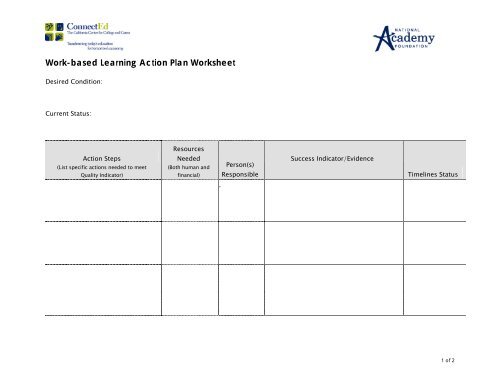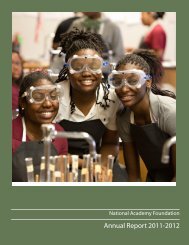Action Plan Worksheet - National Academy Foundation
Action Plan Worksheet - National Academy Foundation
Action Plan Worksheet - National Academy Foundation
Create successful ePaper yourself
Turn your PDF publications into a flip-book with our unique Google optimized e-Paper software.
Career Practicum:A Work-Based Learning StrategyJune 2011Developed in partnership with the following organizations as well as the individuals listed on the inside of this cover.
Special thanks to the members of the Linked Learning Alliance Pathway Development Working Group Work-Based Learning Subcommittee for their contributions to this document.NameRob AtterburyKeith ArchuletaPatricia ClarkSvetlana DarcheDeanna HansonMike HensonPenni HudisCindy McHughKristin MaschkaDan SchlesingerMichael StraitMichelle SwansonApril TreeceRandy WallaceDave YanofskyRepresentingConnectEd: The California Center for College and Career;Chair, Work-Based Learning Subcommittee of the Linked Learning Alliance PathwayWorking GroupEmerald ConsultingCareer <strong>Academy</strong> Support NetworkWestEd<strong>National</strong> <strong>Academy</strong> <strong>Foundation</strong><strong>National</strong> <strong>Academy</strong> <strong>Foundation</strong>ConnectEd: The California Center for College and Career;Co-Chair, Linked Learning Alliance Pathway Working Group<strong>National</strong> <strong>Academy</strong> <strong>Foundation</strong>ConnectEd: The California Center for College and CareerLong Beach Unified School District<strong>National</strong> <strong>Academy</strong> <strong>Foundation</strong>Swanson & Cosgrave ConsultingContra Costa Economic Partnership/Contra Costa Council;Co-Chair, Linked Learning Alliance Pathway Working GroupTulare County Office of EducationConnectEd: The California Center for College and Career
How Does Career Practicum Relate to Other Types of Work-Based LearningExperiences?Work-based learning is a continuum of educational strategies stretching from kindergarten into adulthoodthat are intentionally designed to help students extend and deepen classroom work and make progresstoward learning outcomes that are difficult to achieve through classroom or standard project-based learningalone.The term “work-based” does not mean the experience must occur at a workplace. Work-basedlearning may take place in a workplace, in the community, at school; be supported virtually via technology; ortake place across a combination of all these settings.Work-based learning has threeprimary purposes.• Learning ABOUT work.• Learning THROUGHwork.• Learning FOR work.Traditionally, the work-basedlearning continuum hasencompassed CareerAwareness, Exploration, andPreparation. Career Awarenessand Exploration experiencessupport learning ABOUT work.Career Preparation experiencessupport learning FOR work, namely preparation for a specific range of occupations.Introducing Career Practicum as an additional component of the continuum gives the field a clear way todiscuss and implement experiences that support learning THROUGH work.Career Practicum bridges Career Exploration and Career Preparation, as they have commonly been defined,by providing clarity about the possibilities for experiences in between the two. A specific activity, such as aninternship or a job shadow, may be used in several places along the continuum depending on the studentoutcomes it supports and how it is designed.Work-Based Learning Continuum DefinitionsCareer Awareness Students build awareness of the variety of careers available and begin identifyingareas of interest.Career Exploration Students explore career options for motivation and to inform decision making.Career Practicum Students apply learning through practical experience and interaction with professionalsfrom industry and the community outside of school in order to extend and deepenclassroom work and support the development of college and career readinessknowledge and skills (higher-order thinking, academic skills, technical skills, andapplied workplace skills).Career Preparation Students prepare for employment in a specific range of occupations.2
Definition of Career PracticumCareer Practicum is applied learning that provides students with practical experience and interaction withprofessionals from industry and the community outside of school in order to extend and deepen classroomwork and support the development of college and career readiness knowledge and skills (higher-orderthinking, academic skills, technical skills, and applied workplace skills).Career Practicum experiences have the following characteristics:• Students have direct, systematic interaction with professionals from industry and the community over aperiod of time.• The experience is an integrated part of a sequential preparation for college and career and is alsoexplicitly integrated into students’ current academic and technical curriculum.• The depth and length of the experience is sufficient to enable students to develop and demonstratespecific knowledge and skills.• The experience prioritizes the development of transferable, applied workplace skills while also seekingto reinforce and provide opportunities to apply the basic and higher-order academic skills and technicalskills being learned in the classroom.• Students engage in activities that have consequences beyond the class or value beyond success inschool and are judged by outside professionals from industry and the community using industrystandards.• Students develop skills and knowledge applicable to multiple career and postsecondary educationoptions.Career Practicum experiences do not have to occur at a workplace. They may take place in a workplace, inthe community, or at school; be supported virtually via technology; or take place across a combination of allthese settings.Career Practicum experiences are most suitable for high school students. Ideally, students have more thanone Career Practicum experience in high school, each of which may support subsets of appropriate studentlearning outcomes such that over the course of their experience they have the opportunity to make progresstoward all of the outcomes associated with Career Practicum. In addition, a Career Practicum experience,whether in the form of an internship or an alternative form, can serve as the culminating work-based learningexperience for a high school student in a college and career pathway program.3
Criteria for Designing and Assessing a Career Practicum ExperienceHigh-quality Career Practicum experiences have specific characteristics. The criteria listed here support rigor,consistency, and equity when designing, implementing, and evaluating the effectiveness of the experience insupporting the desired student outcomes.CriteriaPurposeOutcomesRelevanceIntegrationVarietyPreparationInteractionCoordinationReflectionAssessmentCharacteristicsThe Career Practicum experience…Has learning as its primary purpose and is an integrated part of a sequential preparation forcollege and career.Is designed using student learning outcomes, relevant college and career readiness standards,and context-specific professional and industry standards.Is relevant to the student’s career interests, individual learning needs, and the pathway theme;has consequences beyond the class or value beyond success in school.Is integrated into the student’s academic and technical curriculum.Involves a variety of tasks, opportunities to work with multiple adults, and opportunities towork in individual and group settings—without compromising the depth of the experience.Is prefaced by preparation for the student in class and in previous less-intensive experienceswith the academic, technical, and applied workplace skills needed for a Career Practicum experience;orientation for the student to the learning expectations for the experience and to theindividuals and/or organizations with which he/she will be engaged; preparation for the partnersprior to the experience with information about the student, the individual student learningoutcomes, and other information relevant to the experience.Provides opportunities for the student to interact directly with professionals from industry andthe community over a period of time.Is coordinated by the student, teacher, pathway team, partner, and parent/guardian; eachunderstands their respective roles and responsibilities in supporting the experience, ensuringprogress toward student learning outcomes, and communicating with each other before, during,and after the experience.Engages the student in reflection and analysis throughout the experience and after it concludesin order to link the experience back to the student learning outcomes and forward to careerand postsecondary options.Involves the student, pathway team, and partner in assessing progress toward student learningoutcomes and the work produced against college and career readiness standards and contextspecificprofessional standards; asks the student to demonstrate what was learned from theexperience by documenting learning during the experience and presenting at the end toteachers and those with whom he/she has worked.5
Works CitedArchuleta, K. (2010, August). Guide to Effective Work-Based Learning. Antioch, CA: Emerald Consulting.Archuleta, K. (2008, November). Work-Ready/Essential Skills Framework. Antioch, CA: Emerald Consulting.Originally published March 2007.California Department of Education. (2008). 2008–2012 California State <strong>Plan</strong> for Career Technical Education.Appendix A. Essential Skills Enumerated by Recognized Initiatives. Retrieved February 18, 2011,from http://www.wested.org/cteplan.Includes reference to:• Framework for 21 st Century Learning. Partnership for 21 st Century Skills.http://www.p21.org/documents/P21_Framework.pdf• Michael Kane, Sue Berryman, David Goslin, and Ann Meltzer. “Identifying and DescribingThe Skills Required by Work,” Secretary’s Commission on Achieving Necessary Skills, U.S.Department of Labor. September 14, 1990. http://wdr.doleta.gov/SCANS/idsrw/idsrw.pdf• Equipped for the Future: Work Readiness Skills.http://eff.cls.utk.edu/fundamentals/default.htm• CTE Model Curriculum Standards: <strong>Foundation</strong> Standards. California Department ofEducation. http://www.cde.ca.gov/re/pn/fd/documents/careertechstnd.pdf• States’ Career Cluster Initiative Essential Knowledge and Skill Statements. <strong>National</strong>Association of State Directors of CTE Consortium. 2008.http://www.careerclusters.org/resources/pos_ks/Essential%20Statements%20-%20100608.pdf• <strong>National</strong> Career Development Guidelines.http://associationdatabase.com/aws/NCDA/asset_manager/get_file/3384?ver=13331• Are They Really Ready to Work?: Employers’ Perspectives on the Basic Knowledge AndApplied Skills of New Entrants to the 21st Century Workforce, The Conference Board,Corporate Voices for Working Families, Partnership for 21st Century Skills, Society forHuman Resource Management. http://www.p21.org/documents/FINAL_REPORT_PDF09-29-06.pdfConley, D. (2007, March). Redefining College Readiness. Educational Policy Improvement Center. RetrievedFebruary 18, 2011, from http://www.aypf.org/documents/RedefiningCollegeReadiness.pdf.Darche, S. Nayar, N., and Bracco, K. (2009). Work-Based Learning in California: Opportunities and Models forExpansion. San Francisco: The James Irvine <strong>Foundation</strong>. Retrieved February 18, 2011, fromhttp://www.wested.org/online_pubs/workbasedlearning.pdf.<strong>National</strong> <strong>Academy</strong> <strong>Foundation</strong>. (2010, October). Supervisor Assessment of Student Intern: Glossary. PilotDraft.6






